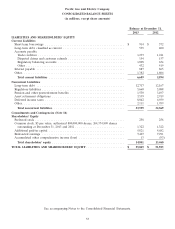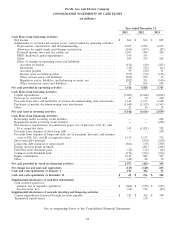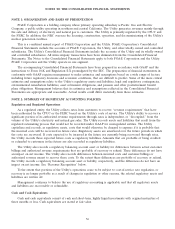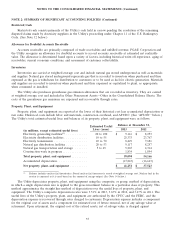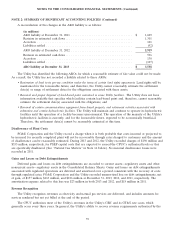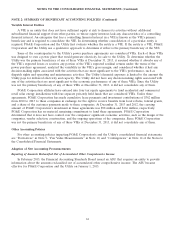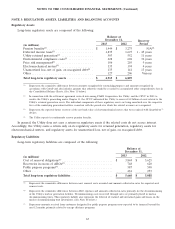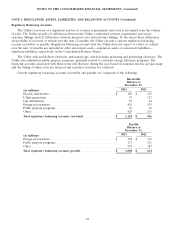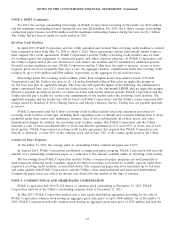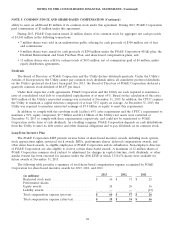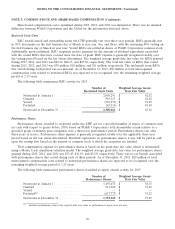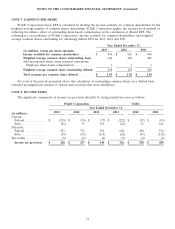PG&E 2013 Annual Report Download - page 67
Download and view the complete annual report
Please find page 67 of the 2013 PG&E annual report below. You can navigate through the pages in the report by either clicking on the pages listed below, or by using the keyword search tool below to find specific information within the annual report.NOTES TO THE CONSOLIDATED FINANCIAL STATEMENTS (Continued)
NOTE 2: SUMMARY OF SIGNIFICANT ACCOUNTING POLICIES (Continued)
Variable Interest Entities
A VIE is an entity that does not have sufficient equity at risk to finance its activities without additional
subordinated financial support from other parties, or whose equity investors lack any characteristics of a controlling
financial interest. An enterprise that has a controlling financial interest in a VIE is known as the VIE’s primary
beneficiary and is required to consolidate the VIE. In determining whether consolidation of a particular entity is
required, PG&E Corporation and the Utility first evaluate whether the entity is a VIE. If the entity is a VIE, PG&E
Corporation and the Utility use a qualitative approach to determine if either is the primary beneficiary of the VIE.
Some of the counterparties to the Utility’s power purchase agreements are considered VIEs. Each of these VIEs
was designed to own a power plant that would generate electricity for sale to the Utility. To determine whether the
Utility was the primary beneficiary of any of these VIEs at December 31, 2013, it assessed whether it absorbs any of
the VIE’s expected losses or receives any portion of the VIE’s expected residual returns under the terms of the
power purchase agreement, analyzed the variability in the VIE’s gross margin, and considered whether it had any
decision-making rights associated with the activities that are most significant to the VIE’s performance, such as
dispatch rights and operating and maintenance activities. The Utility’s financial exposure is limited to the amount the
Utility pays for delivered electricity and capacity. The Utility did not have any decision-making rights associated with
any of the activities that are most significant to the economic performance of any of these VIEs. Since the Utility
was not the primary beneficiary of any of these VIEs at December 31, 2013, it did not consolidate any of them.
PG&E Corporation affiliates have entered into four tax equity agreements to fund residential and commercial
retail solar energy installations with four separate privately held funds that are considered VIEs. Under these
agreements, PG&E Corporation has made cumulative lease payments and investment contributions of $362 million
from 2010 to 2013 to these companies in exchange for the right to receive benefits from local rebates, federal grants,
and a share of the customer payments made to these companies. At December 31, 2013 and 2012, the carrying
amount of PG&E Corporation’s investment in these agreements was $98 million and $166 million, respectively.
PG&E Corporation has no material remaining commitment to fund these agreements. PG&E Corporation
determined that it does not have control over the companies’ significant economic activities, such as the design of the
companies, vendor selection, construction, and the ongoing operations of the companies. Since PG&E Corporation
was not the primary beneficiary of any of these VIEs at December 31, 2013, it did not consolidate any of them.
Other Accounting Policies
For other accounting policies impacting PG&E Corporation’s and the Utility’s consolidated financial statements,
see ‘‘Derivatives’’ in Note 9, ‘‘Fair Value Measurements’’ in Note 10, and ‘‘Contingencies’’ in Note 14 of the Notes to
the Consolidated Financial Statements.
Adoption of New Accounting Pronouncements
Reporting of Amounts Reclassified Out of Accumulated Other Comprehensive Income
In February 2013, the Financial Accounting Standards Board issued an ASU that requires an entity to provide
information about the amounts reclassified out of accumulated other comprehensive income. The ASU became
effective for PG&E Corporation and the Utility on January 1, 2013.
61




